Managerial Behavior, Agency Costs, Ownership Structure Analysis
VerifiedAdded on 2020/04/07
|10
|2849
|135
Essay
AI Summary
This essay provides a comprehensive analysis of managerial behavior, agency costs, and ownership structure within organizations, drawing upon the principles of agency theory. The discussion explores the implications of agency relationships, examining how the separation of ownership and control can lead to conflicts of interest and agency costs. The essay delves into the agency costs of equity and debt, analyzing how these costs impact managerial decision-making, firm value, and ownership structure. It investigates the role of monitoring, bonding agreements, and corporate governance mechanisms in mitigating agency problems. Furthermore, the essay examines the interplay between ownership structure, capital structure, and managerial incentives. It evaluates how factors such as debt levels and managerial equity ownership influence agency costs and firm performance. The analysis incorporates insights from peer-reviewed articles to provide a nuanced understanding of agency theory's application in various organizational contexts, including the impact of agency costs on shareholder wealth maximization. This essay provides a detailed overview of the relationship between managers and stakeholders.
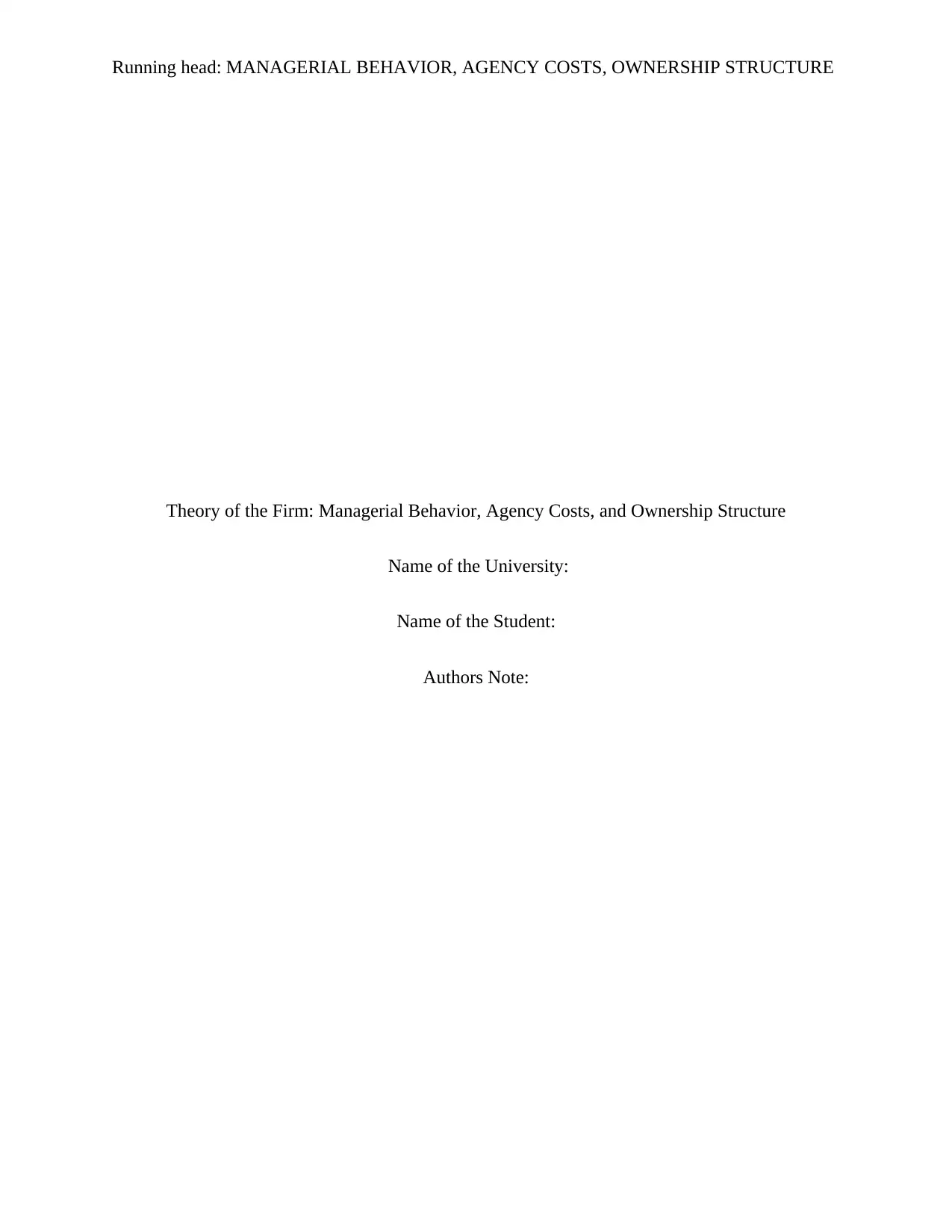
Running head: MANAGERIAL BEHAVIOR, AGENCY COSTS, OWNERSHIP STRUCTURE
Theory of the Firm: Managerial Behavior, Agency Costs, and Ownership Structure
Name of the University:
Name of the Student:
Authors Note:
Theory of the Firm: Managerial Behavior, Agency Costs, and Ownership Structure
Name of the University:
Name of the Student:
Authors Note:
Paraphrase This Document
Need a fresh take? Get an instant paraphrase of this document with our AI Paraphraser
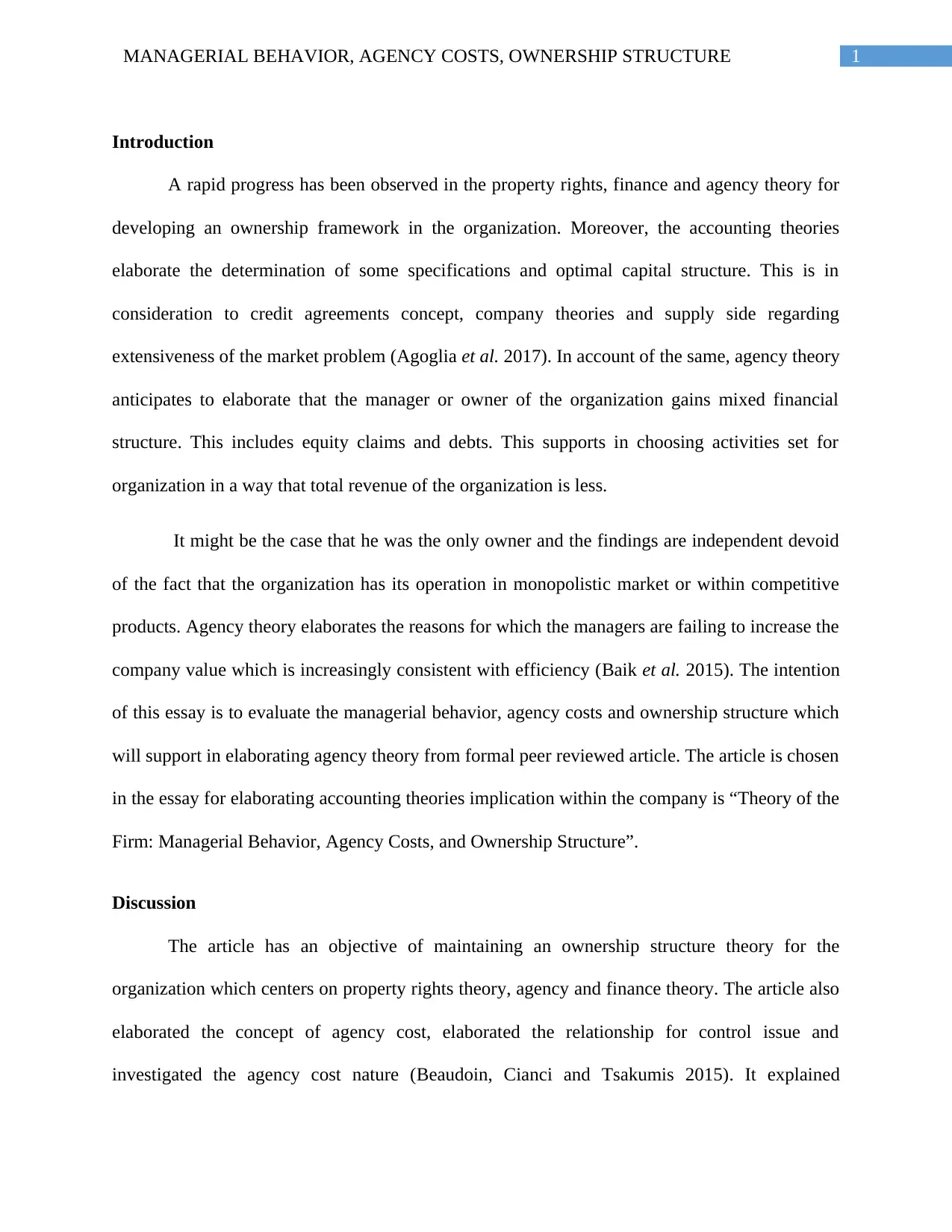
1MANAGERIAL BEHAVIOR, AGENCY COSTS, OWNERSHIP STRUCTURE
Introduction
A rapid progress has been observed in the property rights, finance and agency theory for
developing an ownership framework in the organization. Moreover, the accounting theories
elaborate the determination of some specifications and optimal capital structure. This is in
consideration to credit agreements concept, company theories and supply side regarding
extensiveness of the market problem (Agoglia et al. 2017). In account of the same, agency theory
anticipates to elaborate that the manager or owner of the organization gains mixed financial
structure. This includes equity claims and debts. This supports in choosing activities set for
organization in a way that total revenue of the organization is less.
It might be the case that he was the only owner and the findings are independent devoid
of the fact that the organization has its operation in monopolistic market or within competitive
products. Agency theory elaborates the reasons for which the managers are failing to increase the
company value which is increasingly consistent with efficiency (Baik et al. 2015). The intention
of this essay is to evaluate the managerial behavior, agency costs and ownership structure which
will support in elaborating agency theory from formal peer reviewed article. The article is chosen
in the essay for elaborating accounting theories implication within the company is “Theory of the
Firm: Managerial Behavior, Agency Costs, and Ownership Structure”.
Discussion
The article has an objective of maintaining an ownership structure theory for the
organization which centers on property rights theory, agency and finance theory. The article also
elaborated the concept of agency cost, elaborated the relationship for control issue and
investigated the agency cost nature (Beaudoin, Cianci and Tsakumis 2015). It explained
Introduction
A rapid progress has been observed in the property rights, finance and agency theory for
developing an ownership framework in the organization. Moreover, the accounting theories
elaborate the determination of some specifications and optimal capital structure. This is in
consideration to credit agreements concept, company theories and supply side regarding
extensiveness of the market problem (Agoglia et al. 2017). In account of the same, agency theory
anticipates to elaborate that the manager or owner of the organization gains mixed financial
structure. This includes equity claims and debts. This supports in choosing activities set for
organization in a way that total revenue of the organization is less.
It might be the case that he was the only owner and the findings are independent devoid
of the fact that the organization has its operation in monopolistic market or within competitive
products. Agency theory elaborates the reasons for which the managers are failing to increase the
company value which is increasingly consistent with efficiency (Baik et al. 2015). The intention
of this essay is to evaluate the managerial behavior, agency costs and ownership structure which
will support in elaborating agency theory from formal peer reviewed article. The article is chosen
in the essay for elaborating accounting theories implication within the company is “Theory of the
Firm: Managerial Behavior, Agency Costs, and Ownership Structure”.
Discussion
The article has an objective of maintaining an ownership structure theory for the
organization which centers on property rights theory, agency and finance theory. The article also
elaborated the concept of agency cost, elaborated the relationship for control issue and
investigated the agency cost nature (Beaudoin, Cianci and Tsakumis 2015). It explained
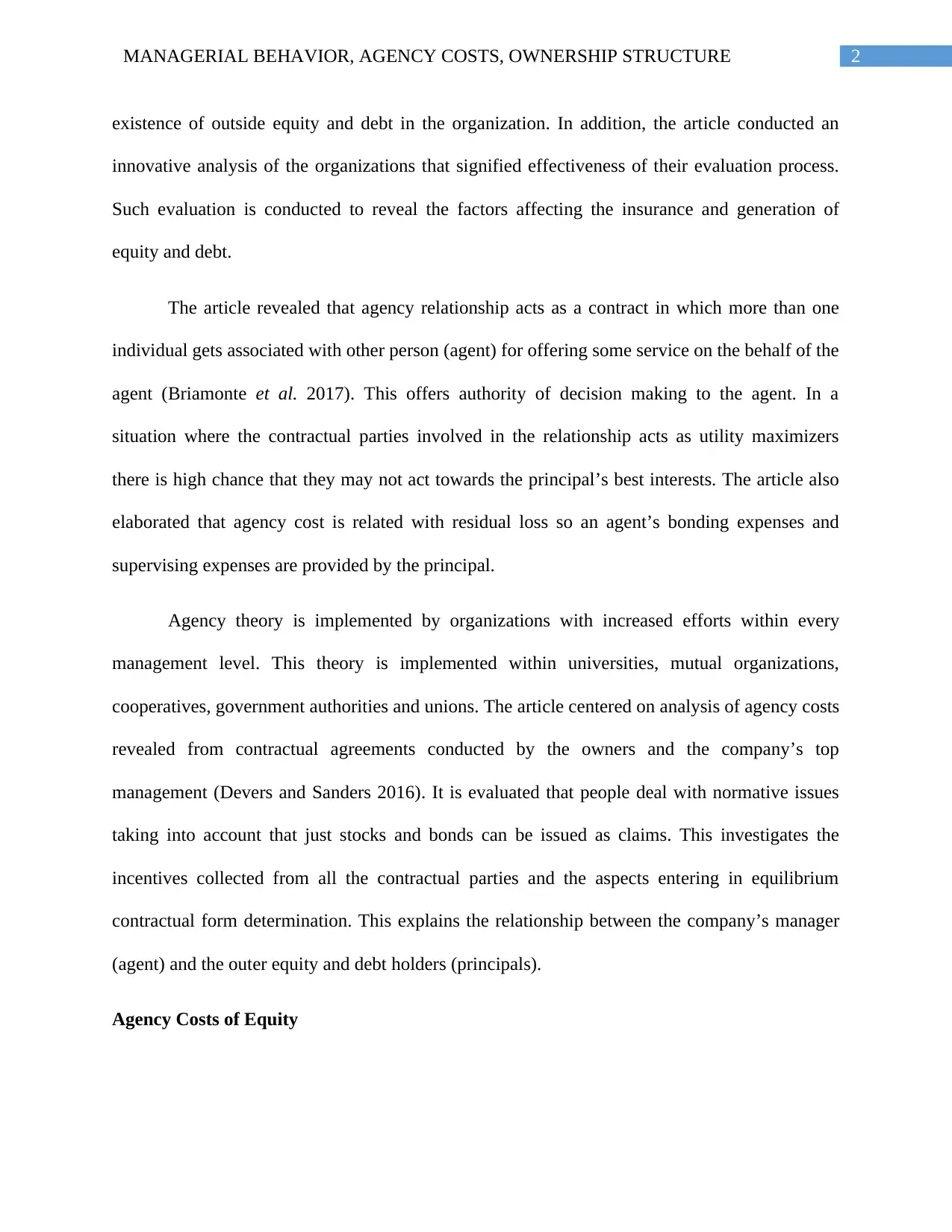
2MANAGERIAL BEHAVIOR, AGENCY COSTS, OWNERSHIP STRUCTURE
existence of outside equity and debt in the organization. In addition, the article conducted an
innovative analysis of the organizations that signified effectiveness of their evaluation process.
Such evaluation is conducted to reveal the factors affecting the insurance and generation of
equity and debt.
The article revealed that agency relationship acts as a contract in which more than one
individual gets associated with other person (agent) for offering some service on the behalf of the
agent (Briamonte et al. 2017). This offers authority of decision making to the agent. In a
situation where the contractual parties involved in the relationship acts as utility maximizers
there is high chance that they may not act towards the principal’s best interests. The article also
elaborated that agency cost is related with residual loss so an agent’s bonding expenses and
supervising expenses are provided by the principal.
Agency theory is implemented by organizations with increased efforts within every
management level. This theory is implemented within universities, mutual organizations,
cooperatives, government authorities and unions. The article centered on analysis of agency costs
revealed from contractual agreements conducted by the owners and the company’s top
management (Devers and Sanders 2016). It is evaluated that people deal with normative issues
taking into account that just stocks and bonds can be issued as claims. This investigates the
incentives collected from all the contractual parties and the aspects entering in equilibrium
contractual form determination. This explains the relationship between the company’s manager
(agent) and the outer equity and debt holders (principals).
Agency Costs of Equity
existence of outside equity and debt in the organization. In addition, the article conducted an
innovative analysis of the organizations that signified effectiveness of their evaluation process.
Such evaluation is conducted to reveal the factors affecting the insurance and generation of
equity and debt.
The article revealed that agency relationship acts as a contract in which more than one
individual gets associated with other person (agent) for offering some service on the behalf of the
agent (Briamonte et al. 2017). This offers authority of decision making to the agent. In a
situation where the contractual parties involved in the relationship acts as utility maximizers
there is high chance that they may not act towards the principal’s best interests. The article also
elaborated that agency cost is related with residual loss so an agent’s bonding expenses and
supervising expenses are provided by the principal.
Agency theory is implemented by organizations with increased efforts within every
management level. This theory is implemented within universities, mutual organizations,
cooperatives, government authorities and unions. The article centered on analysis of agency costs
revealed from contractual agreements conducted by the owners and the company’s top
management (Devers and Sanders 2016). It is evaluated that people deal with normative issues
taking into account that just stocks and bonds can be issued as claims. This investigates the
incentives collected from all the contractual parties and the aspects entering in equilibrium
contractual form determination. This explains the relationship between the company’s manager
(agent) and the outer equity and debt holders (principals).
Agency Costs of Equity
⊘ This is a preview!⊘
Do you want full access?
Subscribe today to unlock all pages.

Trusted by 1+ million students worldwide
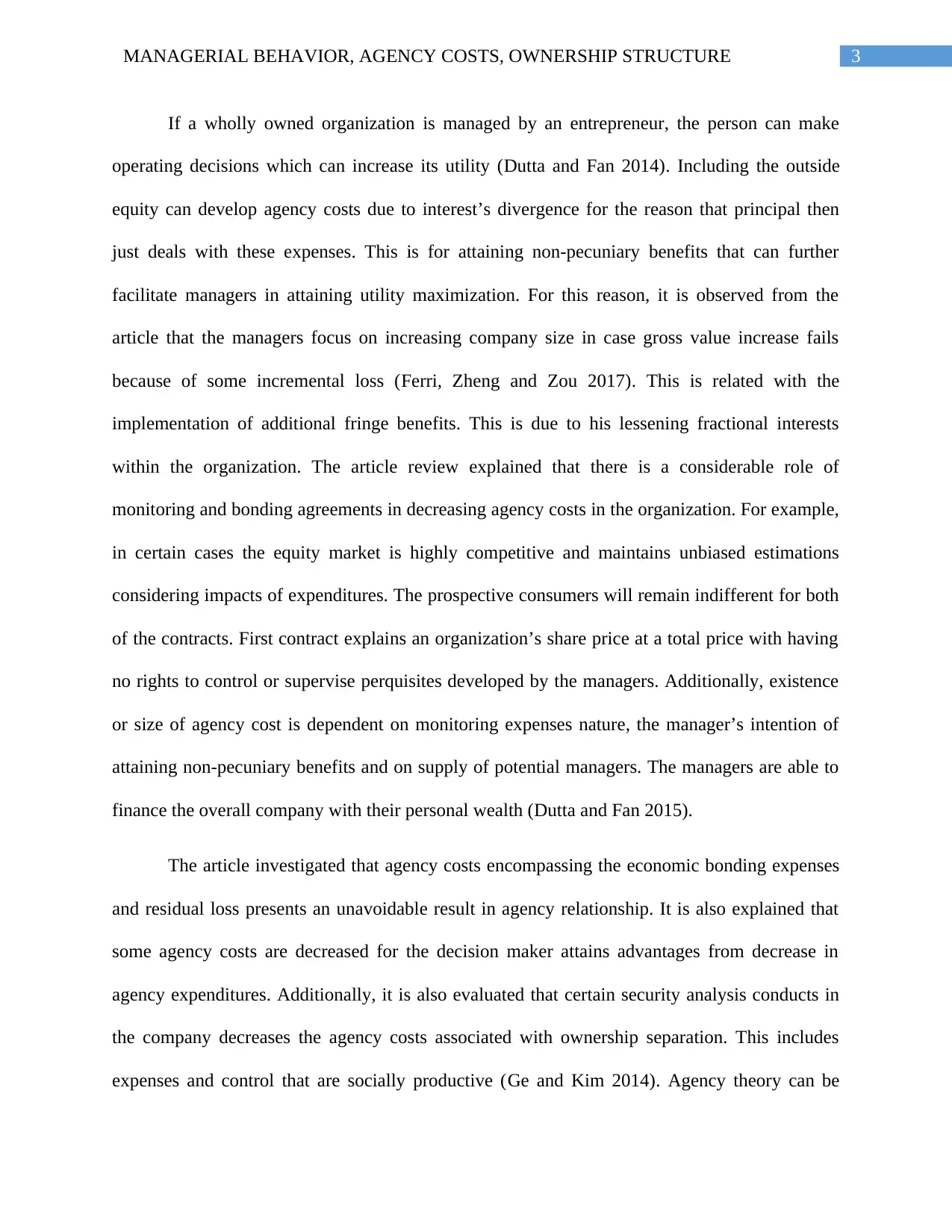
3MANAGERIAL BEHAVIOR, AGENCY COSTS, OWNERSHIP STRUCTURE
If a wholly owned organization is managed by an entrepreneur, the person can make
operating decisions which can increase its utility (Dutta and Fan 2014). Including the outside
equity can develop agency costs due to interest’s divergence for the reason that principal then
just deals with these expenses. This is for attaining non-pecuniary benefits that can further
facilitate managers in attaining utility maximization. For this reason, it is observed from the
article that the managers focus on increasing company size in case gross value increase fails
because of some incremental loss (Ferri, Zheng and Zou 2017). This is related with the
implementation of additional fringe benefits. This is due to his lessening fractional interests
within the organization. The article review explained that there is a considerable role of
monitoring and bonding agreements in decreasing agency costs in the organization. For example,
in certain cases the equity market is highly competitive and maintains unbiased estimations
considering impacts of expenditures. The prospective consumers will remain indifferent for both
of the contracts. First contract explains an organization’s share price at a total price with having
no rights to control or supervise perquisites developed by the managers. Additionally, existence
or size of agency cost is dependent on monitoring expenses nature, the manager’s intention of
attaining non-pecuniary benefits and on supply of potential managers. The managers are able to
finance the overall company with their personal wealth (Dutta and Fan 2015).
The article investigated that agency costs encompassing the economic bonding expenses
and residual loss presents an unavoidable result in agency relationship. It is also explained that
some agency costs are decreased for the decision maker attains advantages from decrease in
agency expenditures. Additionally, it is also evaluated that certain security analysis conducts in
the company decreases the agency costs associated with ownership separation. This includes
expenses and control that are socially productive (Ge and Kim 2014). Agency theory can be
If a wholly owned organization is managed by an entrepreneur, the person can make
operating decisions which can increase its utility (Dutta and Fan 2014). Including the outside
equity can develop agency costs due to interest’s divergence for the reason that principal then
just deals with these expenses. This is for attaining non-pecuniary benefits that can further
facilitate managers in attaining utility maximization. For this reason, it is observed from the
article that the managers focus on increasing company size in case gross value increase fails
because of some incremental loss (Ferri, Zheng and Zou 2017). This is related with the
implementation of additional fringe benefits. This is due to his lessening fractional interests
within the organization. The article review explained that there is a considerable role of
monitoring and bonding agreements in decreasing agency costs in the organization. For example,
in certain cases the equity market is highly competitive and maintains unbiased estimations
considering impacts of expenditures. The prospective consumers will remain indifferent for both
of the contracts. First contract explains an organization’s share price at a total price with having
no rights to control or supervise perquisites developed by the managers. Additionally, existence
or size of agency cost is dependent on monitoring expenses nature, the manager’s intention of
attaining non-pecuniary benefits and on supply of potential managers. The managers are able to
finance the overall company with their personal wealth (Dutta and Fan 2015).
The article investigated that agency costs encompassing the economic bonding expenses
and residual loss presents an unavoidable result in agency relationship. It is also explained that
some agency costs are decreased for the decision maker attains advantages from decrease in
agency expenditures. Additionally, it is also evaluated that certain security analysis conducts in
the company decreases the agency costs associated with ownership separation. This includes
expenses and control that are socially productive (Ge and Kim 2014). Agency theory can be
Paraphrase This Document
Need a fresh take? Get an instant paraphrase of this document with our AI Paraphraser
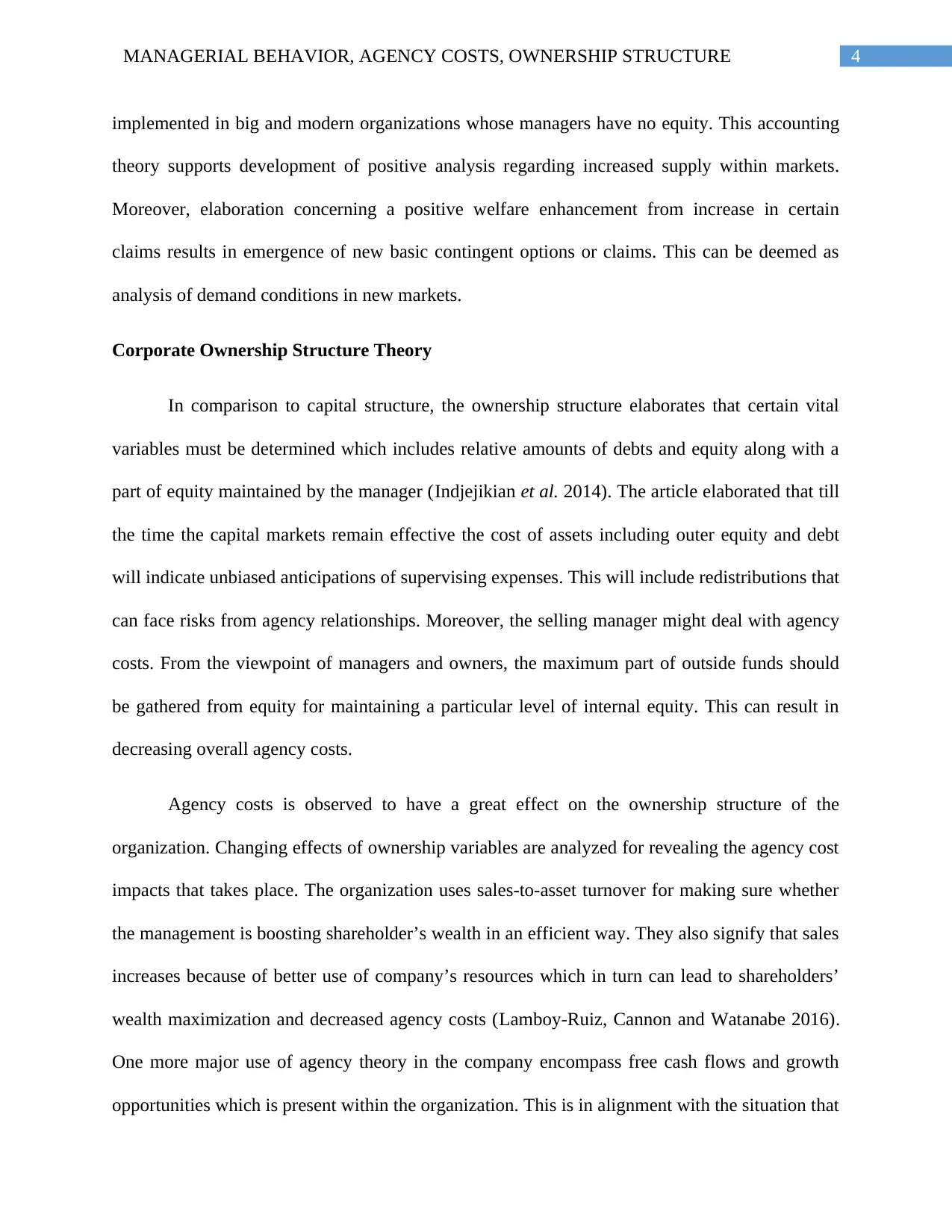
4MANAGERIAL BEHAVIOR, AGENCY COSTS, OWNERSHIP STRUCTURE
implemented in big and modern organizations whose managers have no equity. This accounting
theory supports development of positive analysis regarding increased supply within markets.
Moreover, elaboration concerning a positive welfare enhancement from increase in certain
claims results in emergence of new basic contingent options or claims. This can be deemed as
analysis of demand conditions in new markets.
Corporate Ownership Structure Theory
In comparison to capital structure, the ownership structure elaborates that certain vital
variables must be determined which includes relative amounts of debts and equity along with a
part of equity maintained by the manager (Indjejikian et al. 2014). The article elaborated that till
the time the capital markets remain effective the cost of assets including outer equity and debt
will indicate unbiased anticipations of supervising expenses. This will include redistributions that
can face risks from agency relationships. Moreover, the selling manager might deal with agency
costs. From the viewpoint of managers and owners, the maximum part of outside funds should
be gathered from equity for maintaining a particular level of internal equity. This can result in
decreasing overall agency costs.
Agency costs is observed to have a great effect on the ownership structure of the
organization. Changing effects of ownership variables are analyzed for revealing the agency cost
impacts that takes place. The organization uses sales-to-asset turnover for making sure whether
the management is boosting shareholder’s wealth in an efficient way. They also signify that sales
increases because of better use of company’s resources which in turn can lead to shareholders’
wealth maximization and decreased agency costs (Lamboy-Ruiz, Cannon and Watanabe 2016).
One more major use of agency theory in the company encompass free cash flows and growth
opportunities which is present within the organization. This is in alignment with the situation that
implemented in big and modern organizations whose managers have no equity. This accounting
theory supports development of positive analysis regarding increased supply within markets.
Moreover, elaboration concerning a positive welfare enhancement from increase in certain
claims results in emergence of new basic contingent options or claims. This can be deemed as
analysis of demand conditions in new markets.
Corporate Ownership Structure Theory
In comparison to capital structure, the ownership structure elaborates that certain vital
variables must be determined which includes relative amounts of debts and equity along with a
part of equity maintained by the manager (Indjejikian et al. 2014). The article elaborated that till
the time the capital markets remain effective the cost of assets including outer equity and debt
will indicate unbiased anticipations of supervising expenses. This will include redistributions that
can face risks from agency relationships. Moreover, the selling manager might deal with agency
costs. From the viewpoint of managers and owners, the maximum part of outside funds should
be gathered from equity for maintaining a particular level of internal equity. This can result in
decreasing overall agency costs.
Agency costs is observed to have a great effect on the ownership structure of the
organization. Changing effects of ownership variables are analyzed for revealing the agency cost
impacts that takes place. The organization uses sales-to-asset turnover for making sure whether
the management is boosting shareholder’s wealth in an efficient way. They also signify that sales
increases because of better use of company’s resources which in turn can lead to shareholders’
wealth maximization and decreased agency costs (Lamboy-Ruiz, Cannon and Watanabe 2016).
One more major use of agency theory in the company encompass free cash flows and growth
opportunities which is present within the organization. This is in alignment with the situation that
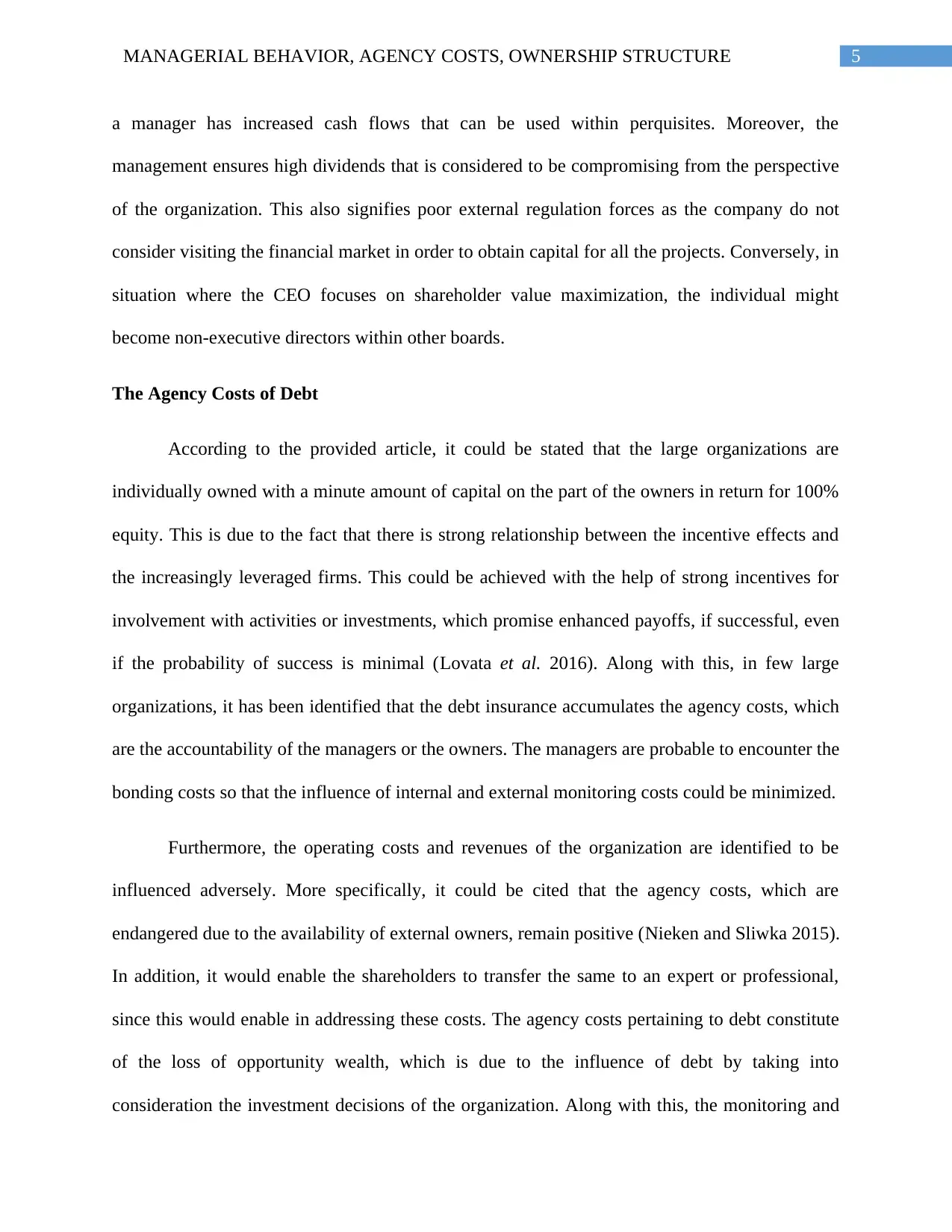
5MANAGERIAL BEHAVIOR, AGENCY COSTS, OWNERSHIP STRUCTURE
a manager has increased cash flows that can be used within perquisites. Moreover, the
management ensures high dividends that is considered to be compromising from the perspective
of the organization. This also signifies poor external regulation forces as the company do not
consider visiting the financial market in order to obtain capital for all the projects. Conversely, in
situation where the CEO focuses on shareholder value maximization, the individual might
become non-executive directors within other boards.
The Agency Costs of Debt
According to the provided article, it could be stated that the large organizations are
individually owned with a minute amount of capital on the part of the owners in return for 100%
equity. This is due to the fact that there is strong relationship between the incentive effects and
the increasingly leveraged firms. This could be achieved with the help of strong incentives for
involvement with activities or investments, which promise enhanced payoffs, if successful, even
if the probability of success is minimal (Lovata et al. 2016). Along with this, in few large
organizations, it has been identified that the debt insurance accumulates the agency costs, which
are the accountability of the managers or the owners. The managers are probable to encounter the
bonding costs so that the influence of internal and external monitoring costs could be minimized.
Furthermore, the operating costs and revenues of the organization are identified to be
influenced adversely. More specifically, it could be cited that the agency costs, which are
endangered due to the availability of external owners, remain positive (Nieken and Sliwka 2015).
In addition, it would enable the shareholders to transfer the same to an expert or professional,
since this would enable in addressing these costs. The agency costs pertaining to debt constitute
of the loss of opportunity wealth, which is due to the influence of debt by taking into
consideration the investment decisions of the organization. Along with this, the monitoring and
a manager has increased cash flows that can be used within perquisites. Moreover, the
management ensures high dividends that is considered to be compromising from the perspective
of the organization. This also signifies poor external regulation forces as the company do not
consider visiting the financial market in order to obtain capital for all the projects. Conversely, in
situation where the CEO focuses on shareholder value maximization, the individual might
become non-executive directors within other boards.
The Agency Costs of Debt
According to the provided article, it could be stated that the large organizations are
individually owned with a minute amount of capital on the part of the owners in return for 100%
equity. This is due to the fact that there is strong relationship between the incentive effects and
the increasingly leveraged firms. This could be achieved with the help of strong incentives for
involvement with activities or investments, which promise enhanced payoffs, if successful, even
if the probability of success is minimal (Lovata et al. 2016). Along with this, in few large
organizations, it has been identified that the debt insurance accumulates the agency costs, which
are the accountability of the managers or the owners. The managers are probable to encounter the
bonding costs so that the influence of internal and external monitoring costs could be minimized.
Furthermore, the operating costs and revenues of the organization are identified to be
influenced adversely. More specifically, it could be cited that the agency costs, which are
endangered due to the availability of external owners, remain positive (Nieken and Sliwka 2015).
In addition, it would enable the shareholders to transfer the same to an expert or professional,
since this would enable in addressing these costs. The agency costs pertaining to debt constitute
of the loss of opportunity wealth, which is due to the influence of debt by taking into
consideration the investment decisions of the organization. Along with this, the monitoring and
⊘ This is a preview!⊘
Do you want full access?
Subscribe today to unlock all pages.

Trusted by 1+ million students worldwide
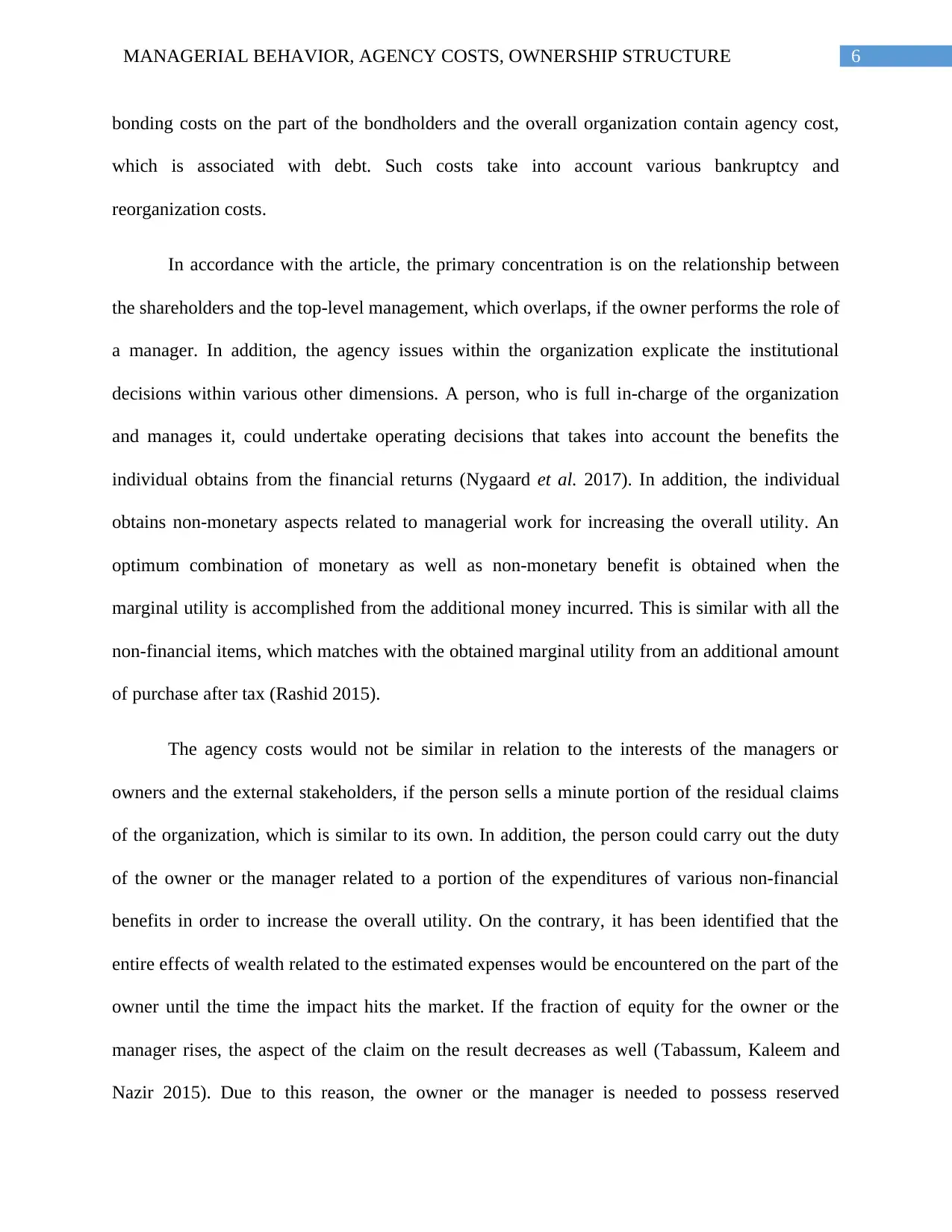
6MANAGERIAL BEHAVIOR, AGENCY COSTS, OWNERSHIP STRUCTURE
bonding costs on the part of the bondholders and the overall organization contain agency cost,
which is associated with debt. Such costs take into account various bankruptcy and
reorganization costs.
In accordance with the article, the primary concentration is on the relationship between
the shareholders and the top-level management, which overlaps, if the owner performs the role of
a manager. In addition, the agency issues within the organization explicate the institutional
decisions within various other dimensions. A person, who is full in-charge of the organization
and manages it, could undertake operating decisions that takes into account the benefits the
individual obtains from the financial returns (Nygaard et al. 2017). In addition, the individual
obtains non-monetary aspects related to managerial work for increasing the overall utility. An
optimum combination of monetary as well as non-monetary benefit is obtained when the
marginal utility is accomplished from the additional money incurred. This is similar with all the
non-financial items, which matches with the obtained marginal utility from an additional amount
of purchase after tax (Rashid 2015).
The agency costs would not be similar in relation to the interests of the managers or
owners and the external stakeholders, if the person sells a minute portion of the residual claims
of the organization, which is similar to its own. In addition, the person could carry out the duty
of the owner or the manager related to a portion of the expenditures of various non-financial
benefits in order to increase the overall utility. On the contrary, it has been identified that the
entire effects of wealth related to the estimated expenses would be encountered on the part of the
owner until the time the impact hits the market. If the fraction of equity for the owner or the
manager rises, the aspect of the claim on the result decreases as well (Tabassum, Kaleem and
Nazir 2015). Due to this reason, the owner or the manager is needed to possess reserved
bonding costs on the part of the bondholders and the overall organization contain agency cost,
which is associated with debt. Such costs take into account various bankruptcy and
reorganization costs.
In accordance with the article, the primary concentration is on the relationship between
the shareholders and the top-level management, which overlaps, if the owner performs the role of
a manager. In addition, the agency issues within the organization explicate the institutional
decisions within various other dimensions. A person, who is full in-charge of the organization
and manages it, could undertake operating decisions that takes into account the benefits the
individual obtains from the financial returns (Nygaard et al. 2017). In addition, the individual
obtains non-monetary aspects related to managerial work for increasing the overall utility. An
optimum combination of monetary as well as non-monetary benefit is obtained when the
marginal utility is accomplished from the additional money incurred. This is similar with all the
non-financial items, which matches with the obtained marginal utility from an additional amount
of purchase after tax (Rashid 2015).
The agency costs would not be similar in relation to the interests of the managers or
owners and the external stakeholders, if the person sells a minute portion of the residual claims
of the organization, which is similar to its own. In addition, the person could carry out the duty
of the owner or the manager related to a portion of the expenditures of various non-financial
benefits in order to increase the overall utility. On the contrary, it has been identified that the
entire effects of wealth related to the estimated expenses would be encountered on the part of the
owner until the time the impact hits the market. If the fraction of equity for the owner or the
manager rises, the aspect of the claim on the result decreases as well (Tabassum, Kaleem and
Nazir 2015). Due to this reason, the owner or the manager is needed to possess reserved
Paraphrase This Document
Need a fresh take? Get an instant paraphrase of this document with our AI Paraphraser
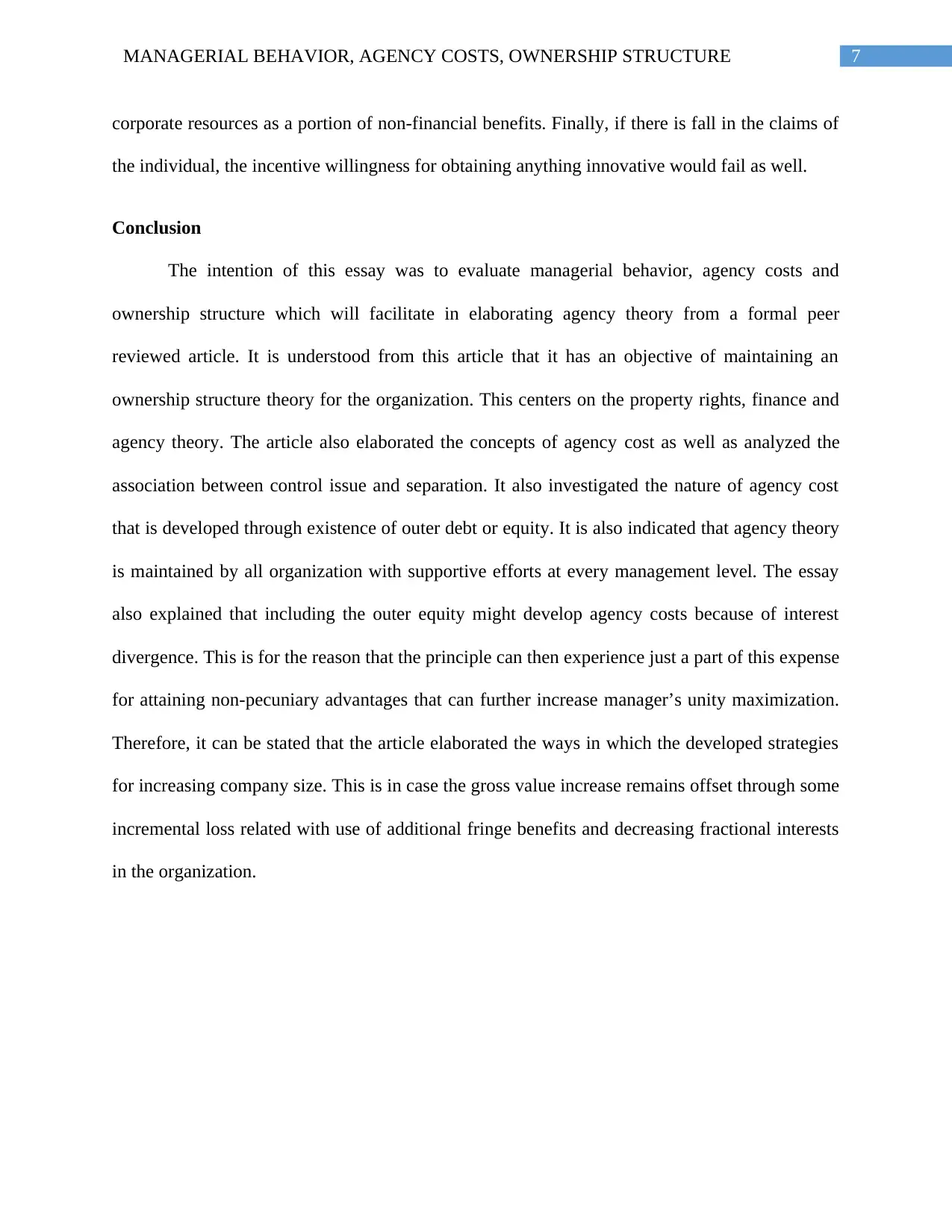
7MANAGERIAL BEHAVIOR, AGENCY COSTS, OWNERSHIP STRUCTURE
corporate resources as a portion of non-financial benefits. Finally, if there is fall in the claims of
the individual, the incentive willingness for obtaining anything innovative would fail as well.
Conclusion
The intention of this essay was to evaluate managerial behavior, agency costs and
ownership structure which will facilitate in elaborating agency theory from a formal peer
reviewed article. It is understood from this article that it has an objective of maintaining an
ownership structure theory for the organization. This centers on the property rights, finance and
agency theory. The article also elaborated the concepts of agency cost as well as analyzed the
association between control issue and separation. It also investigated the nature of agency cost
that is developed through existence of outer debt or equity. It is also indicated that agency theory
is maintained by all organization with supportive efforts at every management level. The essay
also explained that including the outer equity might develop agency costs because of interest
divergence. This is for the reason that the principle can then experience just a part of this expense
for attaining non-pecuniary advantages that can further increase manager’s unity maximization.
Therefore, it can be stated that the article elaborated the ways in which the developed strategies
for increasing company size. This is in case the gross value increase remains offset through some
incremental loss related with use of additional fringe benefits and decreasing fractional interests
in the organization.
corporate resources as a portion of non-financial benefits. Finally, if there is fall in the claims of
the individual, the incentive willingness for obtaining anything innovative would fail as well.
Conclusion
The intention of this essay was to evaluate managerial behavior, agency costs and
ownership structure which will facilitate in elaborating agency theory from a formal peer
reviewed article. It is understood from this article that it has an objective of maintaining an
ownership structure theory for the organization. This centers on the property rights, finance and
agency theory. The article also elaborated the concepts of agency cost as well as analyzed the
association between control issue and separation. It also investigated the nature of agency cost
that is developed through existence of outer debt or equity. It is also indicated that agency theory
is maintained by all organization with supportive efforts at every management level. The essay
also explained that including the outer equity might develop agency costs because of interest
divergence. This is for the reason that the principle can then experience just a part of this expense
for attaining non-pecuniary advantages that can further increase manager’s unity maximization.
Therefore, it can be stated that the article elaborated the ways in which the developed strategies
for increasing company size. This is in case the gross value increase remains offset through some
incremental loss related with use of additional fringe benefits and decreasing fractional interests
in the organization.
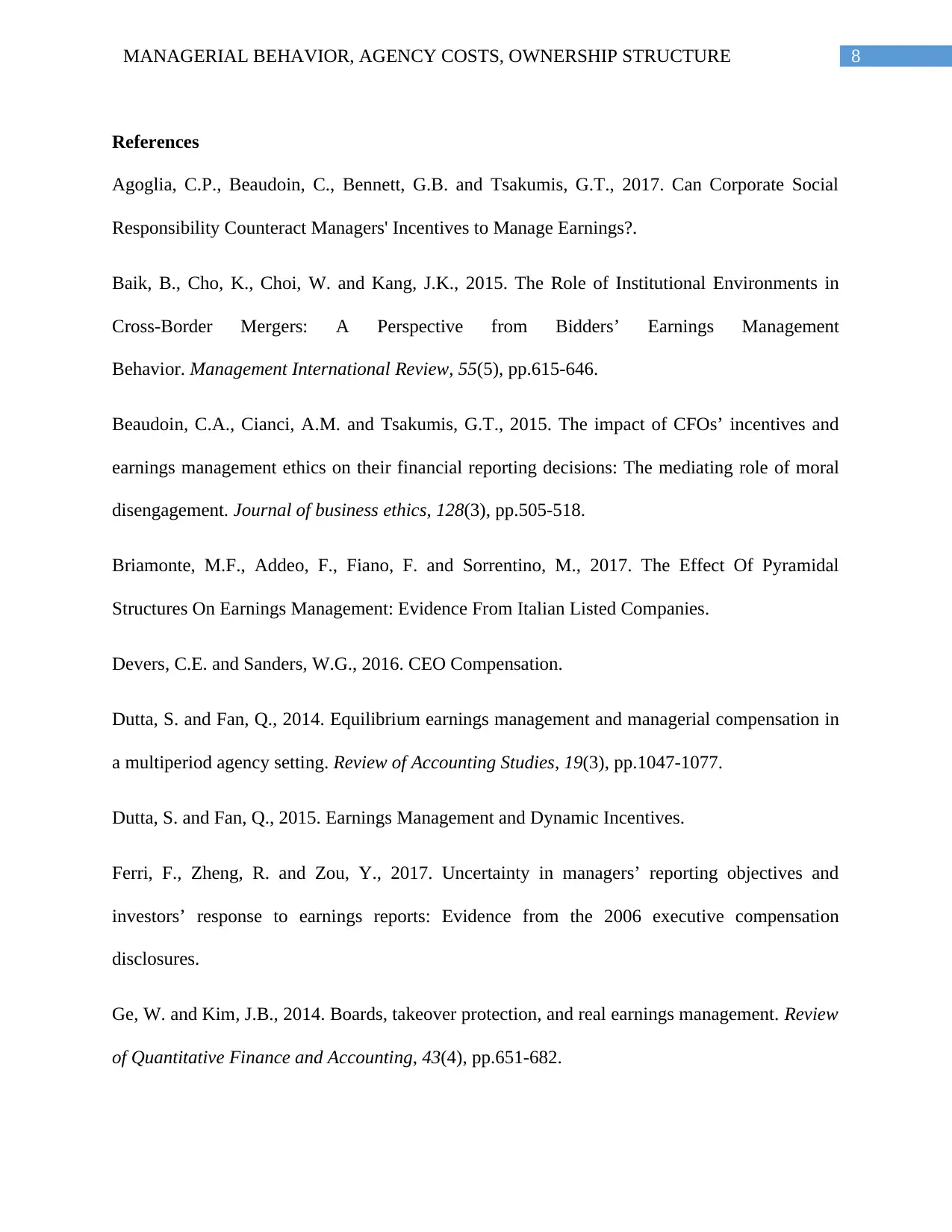
8MANAGERIAL BEHAVIOR, AGENCY COSTS, OWNERSHIP STRUCTURE
References
Agoglia, C.P., Beaudoin, C., Bennett, G.B. and Tsakumis, G.T., 2017. Can Corporate Social
Responsibility Counteract Managers' Incentives to Manage Earnings?.
Baik, B., Cho, K., Choi, W. and Kang, J.K., 2015. The Role of Institutional Environments in
Cross-Border Mergers: A Perspective from Bidders’ Earnings Management
Behavior. Management International Review, 55(5), pp.615-646.
Beaudoin, C.A., Cianci, A.M. and Tsakumis, G.T., 2015. The impact of CFOs’ incentives and
earnings management ethics on their financial reporting decisions: The mediating role of moral
disengagement. Journal of business ethics, 128(3), pp.505-518.
Briamonte, M.F., Addeo, F., Fiano, F. and Sorrentino, M., 2017. The Effect Of Pyramidal
Structures On Earnings Management: Evidence From Italian Listed Companies.
Devers, C.E. and Sanders, W.G., 2016. CEO Compensation.
Dutta, S. and Fan, Q., 2014. Equilibrium earnings management and managerial compensation in
a multiperiod agency setting. Review of Accounting Studies, 19(3), pp.1047-1077.
Dutta, S. and Fan, Q., 2015. Earnings Management and Dynamic Incentives.
Ferri, F., Zheng, R. and Zou, Y., 2017. Uncertainty in managers’ reporting objectives and
investors’ response to earnings reports: Evidence from the 2006 executive compensation
disclosures.
Ge, W. and Kim, J.B., 2014. Boards, takeover protection, and real earnings management. Review
of Quantitative Finance and Accounting, 43(4), pp.651-682.
References
Agoglia, C.P., Beaudoin, C., Bennett, G.B. and Tsakumis, G.T., 2017. Can Corporate Social
Responsibility Counteract Managers' Incentives to Manage Earnings?.
Baik, B., Cho, K., Choi, W. and Kang, J.K., 2015. The Role of Institutional Environments in
Cross-Border Mergers: A Perspective from Bidders’ Earnings Management
Behavior. Management International Review, 55(5), pp.615-646.
Beaudoin, C.A., Cianci, A.M. and Tsakumis, G.T., 2015. The impact of CFOs’ incentives and
earnings management ethics on their financial reporting decisions: The mediating role of moral
disengagement. Journal of business ethics, 128(3), pp.505-518.
Briamonte, M.F., Addeo, F., Fiano, F. and Sorrentino, M., 2017. The Effect Of Pyramidal
Structures On Earnings Management: Evidence From Italian Listed Companies.
Devers, C.E. and Sanders, W.G., 2016. CEO Compensation.
Dutta, S. and Fan, Q., 2014. Equilibrium earnings management and managerial compensation in
a multiperiod agency setting. Review of Accounting Studies, 19(3), pp.1047-1077.
Dutta, S. and Fan, Q., 2015. Earnings Management and Dynamic Incentives.
Ferri, F., Zheng, R. and Zou, Y., 2017. Uncertainty in managers’ reporting objectives and
investors’ response to earnings reports: Evidence from the 2006 executive compensation
disclosures.
Ge, W. and Kim, J.B., 2014. Boards, takeover protection, and real earnings management. Review
of Quantitative Finance and Accounting, 43(4), pp.651-682.
⊘ This is a preview!⊘
Do you want full access?
Subscribe today to unlock all pages.

Trusted by 1+ million students worldwide
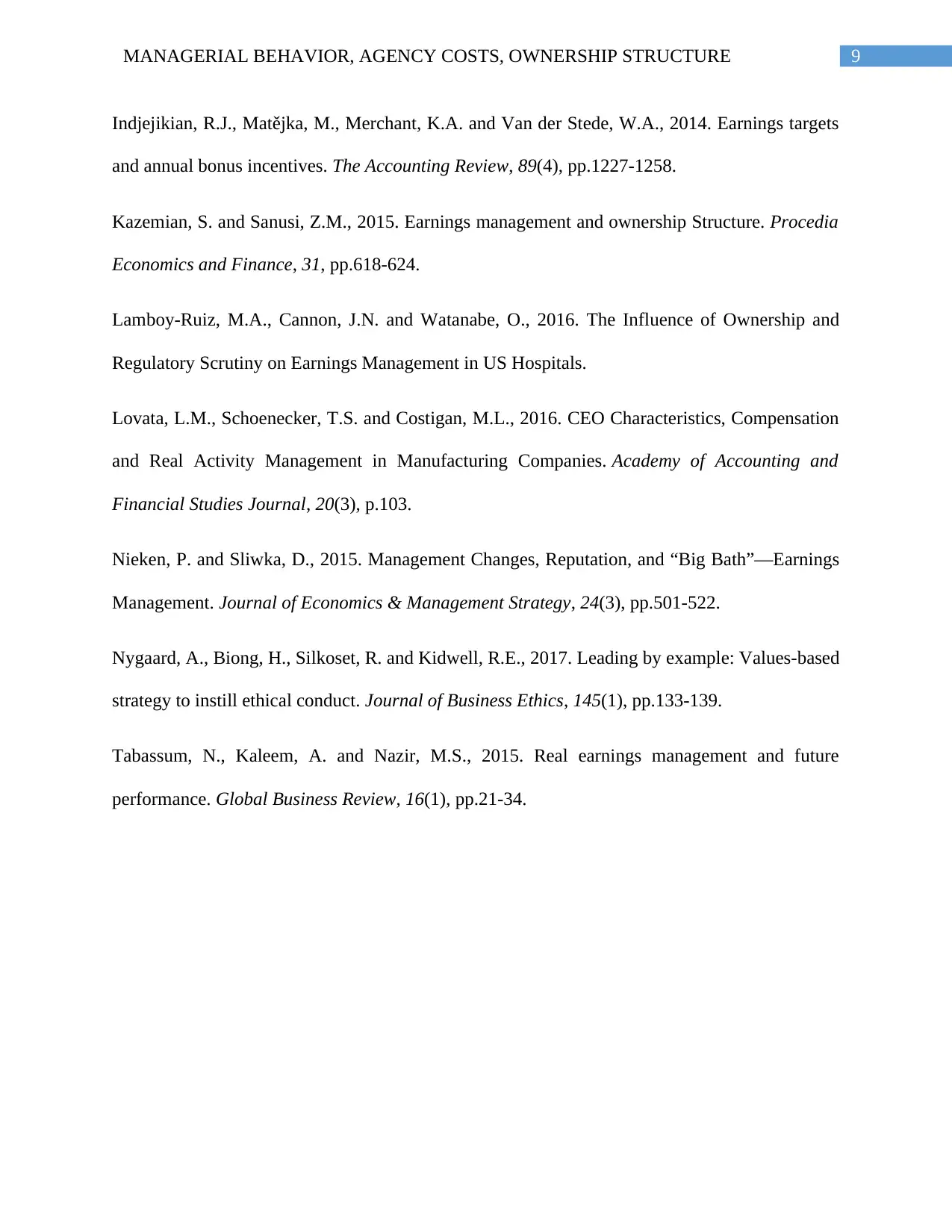
9MANAGERIAL BEHAVIOR, AGENCY COSTS, OWNERSHIP STRUCTURE
Indjejikian, R.J., Matějka, M., Merchant, K.A. and Van der Stede, W.A., 2014. Earnings targets
and annual bonus incentives. The Accounting Review, 89(4), pp.1227-1258.
Kazemian, S. and Sanusi, Z.M., 2015. Earnings management and ownership Structure. Procedia
Economics and Finance, 31, pp.618-624.
Lamboy-Ruiz, M.A., Cannon, J.N. and Watanabe, O., 2016. The Influence of Ownership and
Regulatory Scrutiny on Earnings Management in US Hospitals.
Lovata, L.M., Schoenecker, T.S. and Costigan, M.L., 2016. CEO Characteristics, Compensation
and Real Activity Management in Manufacturing Companies. Academy of Accounting and
Financial Studies Journal, 20(3), p.103.
Nieken, P. and Sliwka, D., 2015. Management Changes, Reputation, and “Big Bath”—Earnings
Management. Journal of Economics & Management Strategy, 24(3), pp.501-522.
Nygaard, A., Biong, H., Silkoset, R. and Kidwell, R.E., 2017. Leading by example: Values-based
strategy to instill ethical conduct. Journal of Business Ethics, 145(1), pp.133-139.
Tabassum, N., Kaleem, A. and Nazir, M.S., 2015. Real earnings management and future
performance. Global Business Review, 16(1), pp.21-34.
Indjejikian, R.J., Matějka, M., Merchant, K.A. and Van der Stede, W.A., 2014. Earnings targets
and annual bonus incentives. The Accounting Review, 89(4), pp.1227-1258.
Kazemian, S. and Sanusi, Z.M., 2015. Earnings management and ownership Structure. Procedia
Economics and Finance, 31, pp.618-624.
Lamboy-Ruiz, M.A., Cannon, J.N. and Watanabe, O., 2016. The Influence of Ownership and
Regulatory Scrutiny on Earnings Management in US Hospitals.
Lovata, L.M., Schoenecker, T.S. and Costigan, M.L., 2016. CEO Characteristics, Compensation
and Real Activity Management in Manufacturing Companies. Academy of Accounting and
Financial Studies Journal, 20(3), p.103.
Nieken, P. and Sliwka, D., 2015. Management Changes, Reputation, and “Big Bath”—Earnings
Management. Journal of Economics & Management Strategy, 24(3), pp.501-522.
Nygaard, A., Biong, H., Silkoset, R. and Kidwell, R.E., 2017. Leading by example: Values-based
strategy to instill ethical conduct. Journal of Business Ethics, 145(1), pp.133-139.
Tabassum, N., Kaleem, A. and Nazir, M.S., 2015. Real earnings management and future
performance. Global Business Review, 16(1), pp.21-34.
1 out of 10
Related Documents
Your All-in-One AI-Powered Toolkit for Academic Success.
+13062052269
info@desklib.com
Available 24*7 on WhatsApp / Email
![[object Object]](/_next/static/media/star-bottom.7253800d.svg)
Unlock your academic potential
Copyright © 2020–2025 A2Z Services. All Rights Reserved. Developed and managed by ZUCOL.





